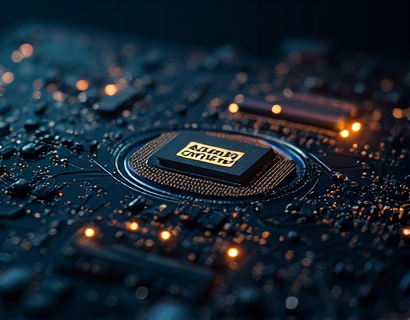Smart Contract Innovations: Creating Stable Pegged Tokens for Seamless DeFi Exchange
In the rapidly evolving world of decentralized finance, or DeFi, smart contracts have emerged as a pivotal technology, transforming the way digital currencies operate. One of the most significant innovations in this space is the creation of stable pegged tokens tied to UCASH, a cryptocurrency known for its stability. These stable tokens offer a unique solution for traders and investors seeking a balance between the volatility of traditional cryptocurrencies and the stability of fiat money. This article delves into the mechanics, benefits, and future potential of smart contract-based stable pegged tokens, providing a comprehensive guide for cryptocurrency enthusiasts and DeFi innovators.
Understanding Stable Pegged Tokens
Stable pegged tokens are digital currencies designed to maintain a stable value relative to a specific asset, in this case, UCASH. Unlike traditional cryptocurrencies like Bitcoin or Ethereum, which can experience significant price fluctuations, stable pegged tokens are anchored to the value of UCASH, reducing volatility and providing a more predictable trading environment. This stability is crucial for DeFi applications, where predictable and stable values are essential for lending, borrowing, and other financial activities.
Role of Smart Contracts in Stable Pegged Tokens
Smart contracts play a vital role in the creation and management of stable pegged tokens. These self-executing contracts with the terms directly written into code ensure that the token's value remains pegged to UCASH through automated mechanisms. The smart contract defines the rules for maintaining the peg, including the algorithms used to adjust the token supply in response to market conditions. This automation not only enhances security and transparency but also reduces the need for intermediaries, making the process more efficient and cost-effective.
Mechanisms for Maintaining the Peg
The maintenance of a stable peg involves several mechanisms, each designed to address potential deviations in the token's value. One common approach is the algorithmic stablecoin model, where the smart contract adjusts the supply of the stable token based on market demand and supply dynamics. When the token's price deviates from the UCASH peg, the smart contract automatically releases or burns tokens to stabilize the price. For instance, if the token price rises above the peg, the smart contract may burn excess tokens to reduce supply and bring the price back down. Conversely, if the price falls below the peg, the smart contract can mint new tokens to increase supply and support the price.
Another mechanism is the reserve-based model, where a portion of the token's value is locked in a reserve of UCASH. This reserve acts as a buffer, ensuring that the smart contract has the necessary funds to maintain the peg. When the token price starts to deviate, the smart contract can draw from this reserve to buy or sell tokens, thereby stabilizing the price. This approach provides an additional layer of security and reliability, as the reserve serves as a safeguard against market fluctuations.
Benefits of Stable Pegged Tokens
The introduction of stable pegged tokens through smart contracts offers numerous benefits to users and the broader DeFi ecosystem. One of the primary advantages is the reduced volatility, which makes these tokens more attractive for everyday transactions and long-term investments. Users can engage in DeFi activities with a higher degree of certainty regarding the value of their assets, reducing the risk of significant losses due to price swings.
Moreover, stable pegged tokens enhance the usability of DeFi platforms. For example, in lending and borrowing protocols, stable tokens provide a stable collateral option, making it easier for users to secure loans or earn interest on their holdings. This stability also facilitates more accurate pricing and risk assessment, leading to more efficient market operations. Additionally, the seamless bidirectional trading enabled by smart contracts allows users to convert between the stable token and UCASH with minimal friction, enhancing the overall user experience.
Enhancing DeFi Ecosystem with Smart Contracts
The integration of smart contracts for stable pegged tokens significantly enhances the DeFi ecosystem. By automating the processes involved in maintaining the peg, smart contracts reduce the potential for human error and increase the speed of transactions. This automation not only improves efficiency but also builds trust among users, who can rely on the contract's immutable and transparent nature.
Furthermore, smart contracts enable the creation of complex financial products and services on the DeFi platform. For instance, decentralized exchanges (DEXs) can leverage stable pegged tokens to offer stable trading pairs, attracting a broader user base. Liquidity pools can be designed to include stable tokens, providing users with more stable and predictable returns. The flexibility of smart contracts also allows for the development of innovative financial instruments, such as stablecoin-backed derivatives and insurance products, further enriching the DeFi landscape.
Challenges and Considerations
While the potential of stable pegged tokens is substantial, there are several challenges and considerations that need to be addressed. One of the primary concerns is the trust in the smart contract itself. Any vulnerabilities or bugs in the code can lead to significant losses, making rigorous auditing and testing essential. Additionally, the governance of the smart contract and the management of the reserve are critical factors. Transparent governance mechanisms and robust reserve management practices are necessary to maintain user trust and the stability of the token.
Another challenge is the regulatory environment. As DeFi continues to grow, regulatory bodies are increasingly scrutinizing these platforms. Ensuring compliance with relevant regulations while maintaining the decentralized nature of the system is a delicate balance. Developers and project teams must stay informed about regulatory changes and adapt their smart contracts accordingly to avoid legal issues.
Future Prospects
The future of stable pegged tokens and smart contract-based DeFi is promising. As the technology matures, we can expect more sophisticated mechanisms for maintaining pegs, such as hybrid models that combine algorithmic and reserve-based approaches. These advancements will further enhance stability and flexibility, making stable tokens even more appealing to a wider audience.
Moreover, the integration of stable pegged tokens with other DeFi protocols, such as decentralized lending and yield farming platforms, will create more comprehensive and user-friendly financial ecosystems. The cross-chain interoperability of smart contracts will also play a crucial role in expanding the reach of these tokens, allowing users to access a global DeFi market.
In conclusion, smart contract innovations for creating stable pegged tokens are revolutionizing the DeFi space. By providing a stable, efficient, and user-friendly solution, these tokens are setting a new standard in digital currency management. As the technology continues to evolve, the potential for further advancements and broader adoption is immense, making this an exciting area to watch in the world of cryptocurrency and decentralized finance.










































